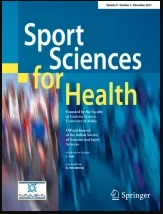Dominic M. Rasp1 · Florian K. Paternoster1 · Felix Hanika1 · Ansgar Schwirtz1
1Biomechanics in Sports, Technical University of Munich, Munich, Germany
Abstract
Hamstring strain injuries (HSI) are associated with low hamstring strength (HSS) and hamstring muscle fatigue (HMF).
Therefore, the frequent testing of HSS can play an important role in the prevention of HSI. The 90:20 Isometric Posterior
Chain Test (90:20 IPCT) efficiently assesses HSS via force plate; yet, the original instruction and its parameter (vertical
force) of this very test may not represent HSS ideally. We, therefore, compared HSS assessed via the optimized instruction
and parameter of this very test with the original version to evaluate which version of the 90:20 IPCT is more sensitive to
detect HMF over the course of a competitive soccer match. Therefore, body mass normalized HSS of twelve outfield soccer
players was assessed pre- and post-match and compared via one-tailed paired samples t-tests and Hedge’s g effect size
as a measure of sensitivity to detect HMF. In addition, we carried out one-tailed one sample t-tests with the decrease of HSS
[%] for each parameter. The optimized version of the 90:20 IPCT shows increased sensitivity to detect hamstring muscle
fatigue compared to the original version of this very test for both the dominant and non-dominant leg in the paired samples
t-tests (g = 0.82; p = 0.005 and g = 1.00; p = 0.002 vs. g = 0.50; p = 0.046 and g = 0.77; p = 0.008, respectively). Regarding
the percentage-wise decrease in HSS, the optimized version of the 90:20 IPCT showed a strong significant decrease in HSS
for both the dominant (g = 0.80; p = 0.006) and the non-dominant leg (g = 1.07; p = 0.001), while the original version did not
detect a significant decrease in HSS in the dominant leg (p = 0.079) but a strong decline in HSS for the non-dominant leg
(g = 0.75; p = 0.009). Although all parameters measured a similar percentage-wise amount of HMF, the optimized version
of the 90:20 IPCT shows higher Hedge’s g effect sizes than the original version in the pre- vs. post-match comparisons of
HSS and also detected HMF, where the original version of the 90:20 IPCT did not. The optimized version should therefore
be preferred when assessing HSS or HMF via the 90:20 IPCT, respectively.
